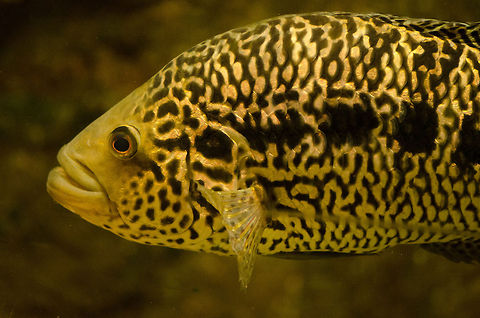
Reproduction
Breeding can be achieved with very little effort and no specific requirements are needed for such purposes. As long as water conditions are maintained at a desirable high quality, a breeding pair of jaguar cichlids will readily spawn. To enhance the likelihood of acquiring a breeding pair, purchase several healthy and active juveniles at a young age and grow these specimens until sexual maturity. Generally, you should be left with a breeding pair or two. These fish will noticeably become more aggressive and territorial, Remove all other fish at this point and keep the newly formed breeding pair separate. When a breeding pair had been successfully established, the male will begin to court the female by displaying his erect finnage as he tries to impress her in an attempt for her to accept his mating invitation. The pair will begin to clean a flat surface if the female is responsive of the male's previous courting behavior. The female with then lay approximately 1000–2000 orange coloured eggs which will then be fertilized by the male. The eggs will be ferociously guarded by both parents and a high degree of parental care is shown to the eggs and fry. When the eggs 'hatch' after approximately 5 to 7 days, the offspring are defenseless and are unable to swim. They are often transported to pre-dug pits by both parents, and are guarded. The fry will begin to swim in approximately 7 days and should be fed with baby brine shrimp or alike. If you would like to rear these fry, they should be removed at this point as they will later be consumed by both parents as the female becomes due to spawn once more. Feed the fry baby brine shrimp until the stage where they are large enough to consume blood worm, daphnia and other live foods. When purchasing fish in an attempt to acquire a breeding pair, try to buy fish from different sources. There is a high probability that when buying fish from the same source, Fish will be from the same parents . This should be avoided, as breeding fish in this manner may form offspring with genetic disease usually associated with interbreeding. Also, buy fish of a similar size, the chances of acquiring a breeding pair with fish of a similar size is significant to that of attempting to breed fish of different age and size.Food
The ''Parachromis'' are a highly predatory group of fish and are by no means fussy eaters. Their ability to protrude their jaw 6% standard length allows them to have a diet composed of 92% evasive prey. These cichlids will readily accept most food substances offered. Diet should be varied however. Offer a variety of insect, including blood worm, earthworm, mysis, crickets . Chopped meat can also be offered along with beef heart along with prawn and fish . Frozen fish is a much preferred method of feeding fish as many "feeder fish" carry the risk of the introducing disease into your aquarium, possibly harming your fish.References:
Some text fragments are auto parsed from Wikipedia.